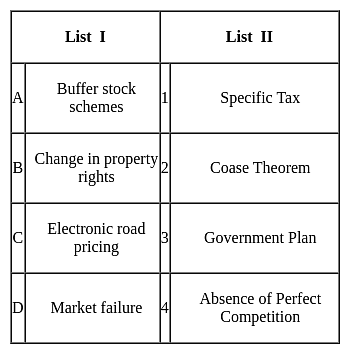UGC NET Paper 2 Economics Mock Test - 2 - UGC NET MCQ
30 Questions MCQ Test UGC NET Mock Test Series 2024 - UGC NET Paper 2 Economics Mock Test - 2
Which sector's growth rates were higher than other countries for China?
| 1 Crore+ students have signed up on EduRev. Have you? Download the App |
What is true about India and China from the above passage ?
Which of the following options accurately presents the sequence (from oldest to most recent) of the Governors of the Reserve Bank of India (RBI)?
A) Urjit Patel
B) Raghuram Rajan
C)Duvvuri Subbarao
D) Shaktikanta Das
Read the following carefully with reference to Human Development in India:
A. Kerala is at the top in human development index.
B. States showing higher total literacy rates have huge gaps between male female literacy.
C. Odisha is among the top five states in human development category.
D. India has been among the medium HDI category.
Choose the correct answer from the options given below:
Indifference curves are convex to the origin because
Which bank has released a report on 28th Jan 15 titled ‘Scaling the Heights: Social Inclusion and Sustainable Development in Himachal Pradesh’, first report of its kind for Himachal Pradesh?
Directions: Arrange the following list in chronological order :
(i) Value and Capital
(ii) Principles of Political Economy and Taxation
(iii) A Revision of Demand Theory
(iv) The General Theory of Employment, Interest and Money
If the mean of the experimental group is 15, the mean of the control group is 12 and the standard deviation of the control group is 5 then the effect size (Δ) will be
Consider the following linear programming problem:
Maximize z = 6x + 10y
Subject to x ≤ 4
y ≤ 6
3x + 2y ≤ 18
x ≥ 0, y ≥ 0
The maximum value of the objective function isConsider the following statements.
1. The Net Domestic Product is the GDP calculated after adjusting the weight of the value of 'depreciation'.
2. The Gross Domestic Product is the 'national income' according to which the International Monetary Fund (IMF) ranks the countries in terms of the volumes at Purchasing Power Parity (PPP).
3. Intermediate goods are now included while calculating the National Income.
Which among the above statements is/are correct?
Which of the following are included in the assets of the Reserve Bank of India?
1. Treasury bills
2. Paid-up Capital and Reserve Fund
3. Ways and means advances
4. Currency Notes in circulation
Which of the following should always be balanced in the foreign trade of India?
According to the passage, the fund collected through Black Money Act can be used for?
According to the passage the Black Money Act is for:
Neo-classical production function has which of the following characteristics?
(a) Positive and diminishing marginal productivity of the factors
(b) Constant return to scale
(c) Satisfies Inada conditions
|
16 docs|120 tests
|




















